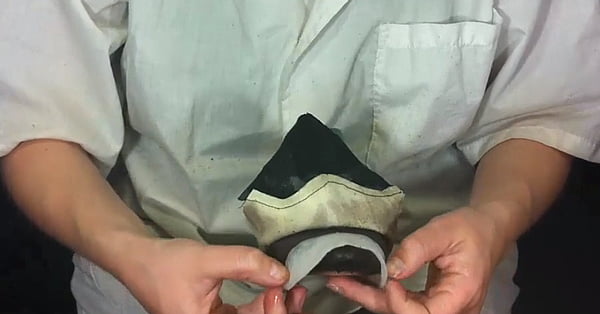Celastic material in Shoemaking
Celastic is a non-woven, chemical fabric activated by solvents. In shoemaking, it's used for stiffening and shaping parts, offering flexibility and form retention once hardened.
What is Celastic?
Celastic is a type of material that is rigid when dry but becomes pliable and moldable when exposed to certain solvents. Additionally, certain shoe glue varieties can function as a solvent. You can learn how to use a glue to activate celastic material in a Sneaker-Making Course .Once the solvent evaporates, the celastic hardens and retains its shape.
Celastic is typically made from a fabric or paper base that has been impregnated with a plasticizer. When exposed to a solvent, the plasticizer becomes activated, allowing the material to be shaped.
Benefits: The primary advantage of using celastic in shoemaking is its ability to provide structure and support to specific parts of a shoe. It's also relatively lightweight and can be easily cut and shaped. Read this article: "How to Make Shoes" to find out more about all the different aspects of the shoe-making knowledge.

Celastic in Shoemaking
In shoemaking, celastic is often used for toe and heel counters. Because it can be molded when wet and then hardens as it dries, it's ideal for creating structured parts of a shoe that need to retain a specific shape.
The most common applications are:
Toe Counters
Toe counters are stiff inserts placed between the shoe's lining and upper at the toe box. They provide shape, support, and protection to the toe area, ensuring the shoe retains its form and offers comfort. Because of this, one of the materials used to make them is celastic. If you're interested in learning how to work with celastic material in shoemaking and use it for toe conter-toe puff, check out this article: “How to work with celastic material in shoemaking?”
Thermoplastic material is another option for crafting toe puffs.

The picture that is above is taken from Fashionable Flat Ballet Shoe course. At this point, the lining must be covered with the activated celastic for the toe puff in order to generate the necessary form.
Heel Counters
Heel counters are rigid inserts positioned between the shoe's lining and upper at the heel. They offer reinforcement, maintaining the shoe's shape at the heel, ensuring a secure fit, and preventing over-pronation or supination.
Note:If you encounter difficulties sourcing celastic material, vegetable-tanned leather can serve as an alternative for shoe stiffeners.
Form and Appearance: Celastic typically comes in sheets and can be cut to the desired shape. It's often white or off-white in color, though the color can vary based on the manufacturer and specific product type.
Thickness: Celastic sheets come in a range of thicknesses to suit different applications. The choice of thickness often depends on the specific requirements of the shoe design and the desired rigidity. For instance, a heavy-duty work boot might require a thicker and more rigid counter than a lightweight dress shoe like Flat Ballet shoes, Slingback pumps or Loafers shoes.
One of the best choices for working with and creating stiffeners is the 1 mm thick celastic material that I include in the shoemaking tools and materiaslkit for the 1-year Shoemaking Program.
